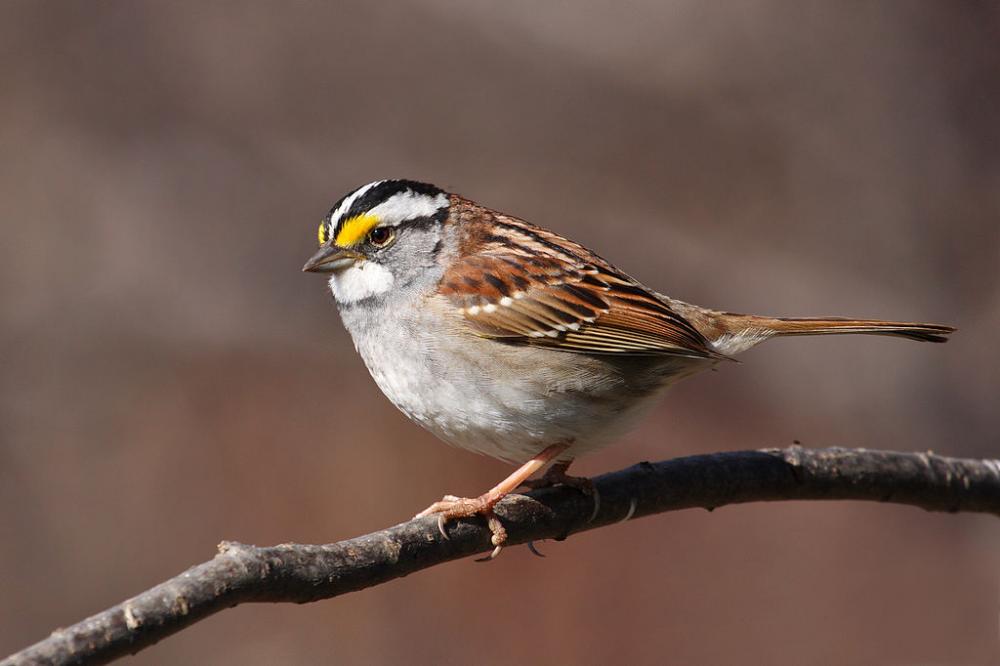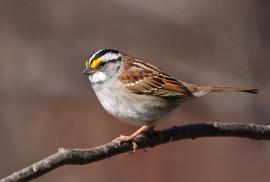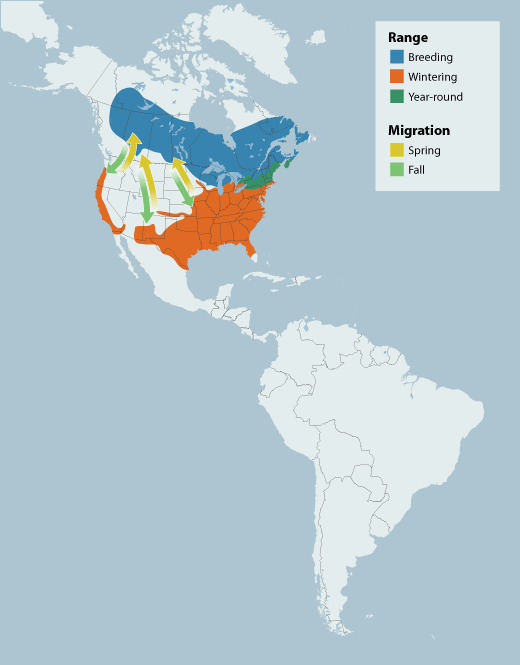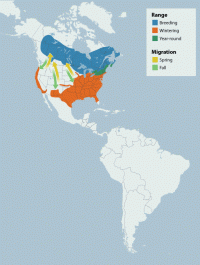Guide to Boreal Birds
This is an in-depth boreal species profile.
What is this?
This species is one of more than 30 birds selected for in-depth profiles. Find out why and see all selected boreal birds »
Overview
A familiar backyard winter bird across most of the eastern and southern U.S., the White-throated Sparrow is also a widespread boreal breeding species. It is almost synonymous with the peaceful expanse of Canada's remote boreal woodlands and its song is practically an anthem for the boreal region's unspoiled wildness. Although many Americans render its familiar song as "Oh Sam Peabody Peabody Peabody," Canadians often think of it as "Pure Sweet Canada, Canada, Canada."
Description
6-7" (15-18 cm). Upperparts streaked, underparts clear gray. There are 2 color forms, one with black and white head stripes, the other with tan and black head stripes. Both have sharply defined white throat patch; dark bill. Females and young birds are duller. Similar White-crowned Sparrow lacks white throat patch, is slimmer, and has a pink bill.
Voice
Song a clear, whistled Poor Sam Peabody, Peabody, Peabody, or Sweet Sweet Canada, Canada, Canada. The latter rendition is perhaps more appropriate, since most of these birds breed in Canada.
Nesting
4 or 5 pale green eggs, heavily spotted with brown, in a cup of grass, rootlets, and moss on or near the ground in forest undergrowth.
Habitat
The White-throated Sparrow commonly uses low, dense cover next to open foraging areas. On the breeding grounds, such habitat occurs mostly around beaver ponds and rock outcrops, in disturbed areas, and at tree line. During migration and winter this sparrow is found in thick cover such as woodlot edges, hedgerows, and weedy fields and commonly in urban habitats.
Range/Migration
This species' winter range extends from southern Nova Scotia to central Florida, northeastern Mexico, and Iowa, extending into the Great Plains and upper Midwest along major river valleys. There is a disjunct winter population on the Pacific coast. Although breeding and winter ranges overlap somewhat, most or all populations are migratory. Even though this species is one of the best-studied North American songbirds, its migration routes and behavior are not well documented. Most birds seem to move more-or-less directly between breeding and winter grounds. The species usually migrates in loose flocks, flying at night and foraging during the day. Fall migration begins in September, with the last birds leaving the breeding grounds by mid-October (before the first permanent snowfall). As with most species, fall migration is slower than spring migration, with longer stopovers. Birds arrive back on the breeding grounds from mid-April to early June after the forest floor is exposed by snowmelt.
Breeding
Eighty-five percent of the global population of the White-throated Sparrow breeds in the boreal forest ecosystem. The breeding range extends from the southeastern Yukon Territory east across Canada through the boreal forest to the Maritimes and south to the northern Great Lakes and mid-Atlantic regions. The breeding biology of this species is apparently unique among birds. Two color morphs (white-striped and tan-striped) occur and pairs are nearly always mixed. Because of genetic differences between the morphs, mixed pairs produce (at the population level) equal numbers of each sex and morph. White-striped males are more aggressive and territorial and less faithful than tan-striped males and tan-striped females provide more parental care than white-striped females. Thus, tan-striped females are apparently obligated (and programmed) to increase their parental care to offset the relative lack of attention from their pugnacious, philandering mates. Uniform pairs are deficient in either territoriality or parental care and thus are rare. White-striped females also sing and thus are likely to be expelled from white-striped males' territories. For unknown reasons, tan-striped male/white-striped female pairs are less particular than their counterparts in terms of vegetation density. White-throated Sparrow nests are generally well-concealed open cups on or near the ground. Clutch size is usually four; incubation is about 12 days and the young usually leave the nest at eight to nine days. Parasitism by Brown-headed Cowbirds (Molothrus ater) is rare in this species, probably because cowbirds are rare within its breeding range; however, this may change with changes in land use.
Diet/Feeding Behavior
The White-throated Sparrow, like many of its relatives, eats mostly terrestrial arthropods (insects, spiders, millipedes, and centipedes) in summer and small fruits and seeds the rest of the year. Overall, the diet is about 20 percent animal and 80 percent vegetable. Principal food plants are ragweed, smartweed, sumac, grape, highbush cranberry, and mountain ash. In early spring it eats a variety of tree buds and flowers (e.g., oak, apple, maple, and beech). It usually forages on the ground near cover, venturing farther from cover as food is depleted. In summer it forages more above ground in small bushes and lower portions of coniferous trees, systematically gleaning food items from stems and leaves along the upper surfaces of horizontal branches. Breeding males may forage in treetops between singing bouts. Subordinate individuals in winter flocks feed frenetically or visit food sources discontinuously to avoid being displaced by dominant birds.
References
Atkinson, C. T., and C. J. Ralph. 1980. Acquisition of plumage polymorphism in White-throated Sparrows. Auk 97:245-252.
Falls, J. B., and J. G. Kopachena. 1994. White-throated Sparrow (Zonotrichia albicollis). In The Birds of North America, No. 128 (A. Poole and F. Gill, Eds.). Philadelphia: The Academy of Natural Sciences; Washington, D.C.: The American Ornithologists' Union.
Knapton, R. W., R. V. Cartar, and J. B. Falls. 1984. A comparison of breeding ecology and reproductive success between morphs of the White-throated Sparrow. Wilson Bull. 96:60-71.
National Audubon Society. 2002. The Christmas Bird Count Historical Results [Online]. http://www.audubon.org/bird/cbc.
Sauer, J. R., J. E. Hines, and J. Fallon. 2003. The North American Breeding Bird Survey, Results and Analysis 1966-2002, Version 2003.1, USGS Patuxent Wildlife Research Center, Laurel, MD.
Schneider, K. J. 1984. Dominance, predation, and optimal foraging in White-throated Sparrow flocks. Ecology 65:1820-1827.
Credits
Birding content provided by National Wildlife Federation/eNature, with support from Ducks Unlimited/The Pew Charitable Trusts.





